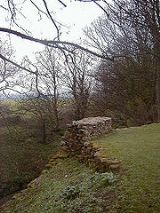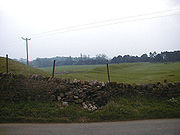
Stanwick Iron Age Fortifications
Encyclopedia


Iron Age
The Iron Age is the archaeological period generally occurring after the Bronze Age, marked by the prevalent use of iron. The early period of the age is characterized by the widespread use of iron or steel. The adoption of such material coincided with other changes in society, including differing...
hill fort
Hill fort
A hill fort is a type of earthworks used as a fortified refuge or defended settlement, located to exploit a rise in elevation for defensive advantage. They are typically European and of the Bronze and Iron Ages. Some were used in the post-Roman period...
comprising over 9 kilometres (5.6 mi) of ditches and ramparts enclosing approximately 300 hectares (700 acres) of land, are situated in Richmondshire
Richmondshire
Richmondshire is a local government district of North Yorkshire, England. It covers a large northern area of the Yorkshire Dales including Swaledale and Arkengarthdale, Wensleydale and Coverdale, with the prominent Scots' Dyke and Scotch Corner along the centre. Teesdale lies to the north...
, North Yorkshire
North Yorkshire
North Yorkshire is a non-metropolitan or shire county located in the Yorkshire and the Humber region of England, and a ceremonial county primarily in that region but partly in North East England. Created in 1974 by the Local Government Act 1972 it covers an area of , making it the largest...
, England
England
England is a country that is part of the United Kingdom. It shares land borders with Scotland to the north and Wales to the west; the Irish Sea is to the north west, the Celtic Sea to the south west, with the North Sea to the east and the English Channel to the south separating it from continental...
. They are located 8 miles (12.9 km) north of the town of Richmond
Richmond, North Yorkshire
Richmond is a market town and civil parish on the River Swale in North Yorkshire, England and is the administrative centre of the district of Richmondshire. It is situated on the edge of the Yorkshire Dales National Park, and serves as the Park's main tourist centre...
and 10 miles (16.1 km) south west of Darlington
Darlington
Darlington is a market town in the Borough of Darlington, part of the ceremonial county of County Durham, England. It lies on the small River Skerne, a tributary of the River Tees, not far from the main river. It is the main population centre in the borough, with a population of 97,838 as of 2001...
, close to Scotch Corner
Scotch Corner
Scotch Corner is an important junction of the A1 and A66 trunk roads near Richmond, North Yorkshire, England. It has been described as "the modern gateway to Cumbria, the North East and Scotland".-Geography:...
and the remains of the Roman fort and bridge at Piercebridge
Piercebridge
Piercebridge is a village and civil parish in the borough of Darlington and the ceremonial county of Durham, England. It is situated a few miles west of the town of Darlington. It is on the site of a Roman fort of AD 260-270, which was built at the point where Dere Street crossed the River Tees....
. Rising to a height of almost 5 metres (16 ft) in places, the ramparts completely surround the village of Stanwick St John
Stanwick St John
Stanwick St John is a village and civil parish in the Richmondshire district of North Yorkshire, England. It is situated between the towns of Darlington and Richmond, close to Scotch Corner and the remains of the Roman fort and bridge at Piercebridge....
and form one of the largest Iron Age settlements in Britain. The name 'Stanwick' is thought to be derived from the Old Norse
Old Norse
Old Norse is a North Germanic language that was spoken by inhabitants of Scandinavia and inhabitants of their overseas settlements during the Viking Age, until about 1300....
word 'steinvegges', meaning stone walls.
Stanwick was the site of Sir Mortimer Wheeler
Mortimer Wheeler
Brigadier Sir Robert Eric Mortimer Wheeler CH, CIE, MC, FBA, FSA , was one of the best-known British archaeologists of the twentieth century.-Education and career:...
's last major archaeological excavation in Britain, which he carried out over the summers of 1951 and 1952. Wheeler argued that the vast site had been constructed in three separate 'phases' starting from a modest 17 acres (68,796.6 m²) earthwork enclosure on a low hill known as 'The Tofts', dated to around 40 AD (Phase I) then extended around 50-60AD with a new enclosure to the north of over 130 acres (Phase II), and then finally, around 72AD, extended by a further 600 acres (2.4 km²) to the south (Phase III).
During the course of his excavations, Wheeler cleared a 50 feet (15.2 m) section of ditch that the Brigantes
Brigantes
The Brigantes were a Celtic tribe who in pre-Roman times controlled the largest section of what would become Northern England, and a significant part of the Midlands. Their kingdom is sometimes called Brigantia, and it was centred in what was later known as Yorkshire...
had cut from the underlying limestone rock. He partially reconstructed a 10 feet (3 m) length of dry-stone revetment wall from the fallen stones found in the ditch. This was constructed to an approximate height of 2 foot (0.6096 m) above the existing rampart, although Wheeler estimated that the original height of the wall above the rampart was probably closer to 15 feet (4.6 m). Known as 'Wheeler's Wall', this entire section remains preserved by English Heritage
English Heritage
English Heritage . is an executive non-departmental public body of the British Government sponsored by the Department for Culture, Media and Sport...
and provides the visitor to Stanwick with a clear impression of how awe-inspiring the fortifications would have been in Iron Age times.
Amongst Wheeler's most famous finds at Stanwick were an Iron Age sword, unusually still in its well-preserved ash wood scabbard, and the nearby skull of a severed head, showing considerable damage from wounds inflicted by an axe or a sword. These were found in an excavation of a ditch terminal next to the location of the main north western gate and Wheeler believed they may have been hanging from the gate structure itself as a trophy or warning to enemies.
Wheeler concluded that Stanwick had been the rebel stronghold of Venutius
Venutius
Venutius was a 1st century king of the Brigantes in northern Britain at the time of the Roman conquest. Some have suggested he may have belonged to the Carvetii, a tribe which probably formed part of the Brigantes confederation....
, who had been the husband of the pro-Roman Brigantian queen Cartimandua
Cartimandua
Cartimandua or Cartismandua was a queen of the Brigantes, a Celtic people in what is now Northern England, in the 1st century. She came to power around the time of the Roman conquest of Britain, and formed a large tribal agglomeration that became loyal to Rome...
, after he had split with her when she had taken his charioteer and armour-bearer Vellocatus
Vellocatus
Vellocatus was a 1st century king of the Brigantes tribe of northern Britain.He was originally armour-bearer to Venutius, husband of Cartimandua, the queen of the Brigantes and an ally of Rome. Some time after 51 AD Cartimandua split with Venutius, marrying Vellocatus and elevating him to kingship...
as a lover and betrayed the rebel leader Caractacus to the Romans. Wheeler argued that Stanwick was the location where Venutius
Venutius
Venutius was a 1st century king of the Brigantes in northern Britain at the time of the Roman conquest. Some have suggested he may have belonged to the Carvetii, a tribe which probably formed part of the Brigantes confederation....
had rallied his anti-Roman tribesmen and allies for his revolt against the Roman invaders.
The next series of major archaeological excavations at Stanwick were carried out from 1981 to 1986 by a team from Durham University led by Percival Turnbull and Professor Colin Haselgrove. One of their most enigmatic finds was an adult male burial at the rear of a rampart in the fortifications where a horse's head had been carefully placed upon the body. Turnbull and Haselgrove argued that Stanwick's huge outer circuit of ditches and banks had probably been built first, during the mid-first century AD, and then the inner area sub-divided. They maintained that the six mile (10 km) fortification was too long to be easily defended and that its enormous size was intended instead to emphasise the power, prestige and wealth of its owner. They concluded that Stanwick had not been the fortress stronghold of Venutius
Venutius
Venutius was a 1st century king of the Brigantes in northern Britain at the time of the Roman conquest. Some have suggested he may have belonged to the Carvetii, a tribe which probably formed part of the Brigantes confederation....
but was rather the estate of his ex-wife, Queen Cartimandua
Cartimandua
Cartimandua or Cartismandua was a queen of the Brigantes, a Celtic people in what is now Northern England, in the 1st century. She came to power around the time of the Roman conquest of Britain, and formed a large tribal agglomeration that became loyal to Rome...
, and possibly even the original tribal capital of the Brigantes
Brigantes
The Brigantes were a Celtic tribe who in pre-Roman times controlled the largest section of what would become Northern England, and a significant part of the Midlands. Their kingdom is sometimes called Brigantia, and it was centred in what was later known as Yorkshire...
.
In 1843 a hoard of 140 metal artefacts known as the 'Stanwick hoard', which included four sets of horse harness for chariots and a bronze horse head 'bucket attachment', were found half a mile away at Melsonby. These are now held by the British Museum
British Museum
The British Museum is a museum of human history and culture in London. Its collections, which number more than seven million objects, are amongst the largest and most comprehensive in the world and originate from all continents, illustrating and documenting the story of human culture from its...
, which also has the Meyrick Helmet
Meyrick Helmet
The Meyrick Helmet is an Iron Age bronze peaked helmet, with La Tène style decoration, that is held at the British Museum in London. It is one of only two Iron Age helmets to have been discovered in Britain, the other one being the more famous Waterloo Helmet...
, which may have been part of the hoard, or made at Stanwick.
Whether Stanwick was the stronghold of Venutius
Venutius
Venutius was a 1st century king of the Brigantes in northern Britain at the time of the Roman conquest. Some have suggested he may have belonged to the Carvetii, a tribe which probably formed part of the Brigantes confederation....
or Cartimandua
Cartimandua
Cartimandua or Cartismandua was a queen of the Brigantes, a Celtic people in what is now Northern England, in the 1st century. She came to power around the time of the Roman conquest of Britain, and formed a large tribal agglomeration that became loyal to Rome...
, or perhaps of them both for a brief time before their acrimonious split some time after 51AD, it is certain that this settlement was one of the most important in the kingdom of the Brigantes
Brigantes
The Brigantes were a Celtic tribe who in pre-Roman times controlled the largest section of what would become Northern England, and a significant part of the Midlands. Their kingdom is sometimes called Brigantia, and it was centred in what was later known as Yorkshire...
during the early stages of the Roman occupation of Britain.

